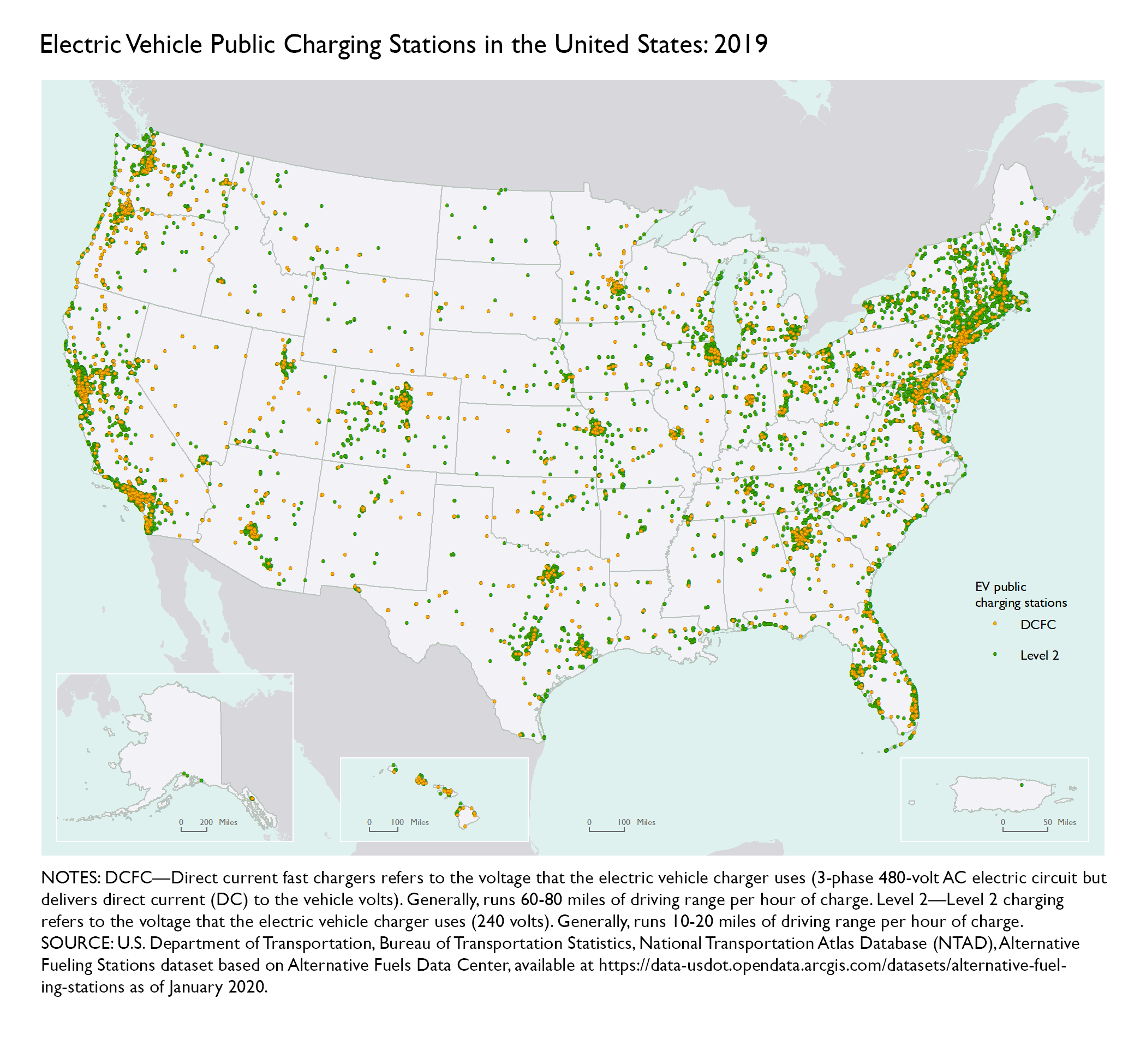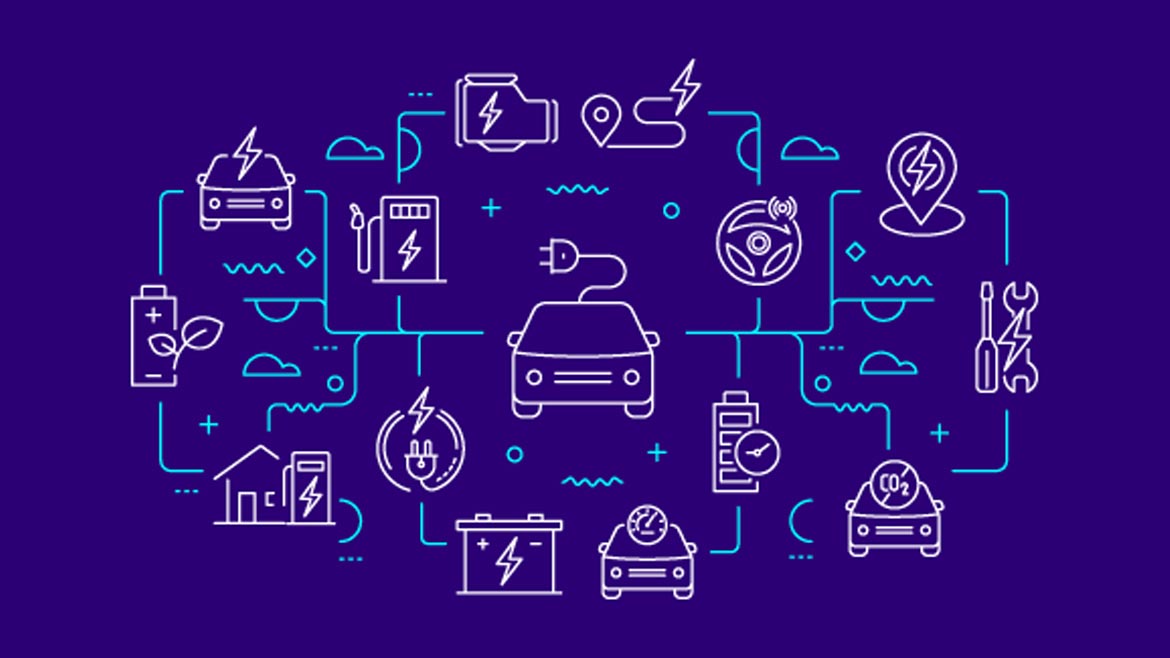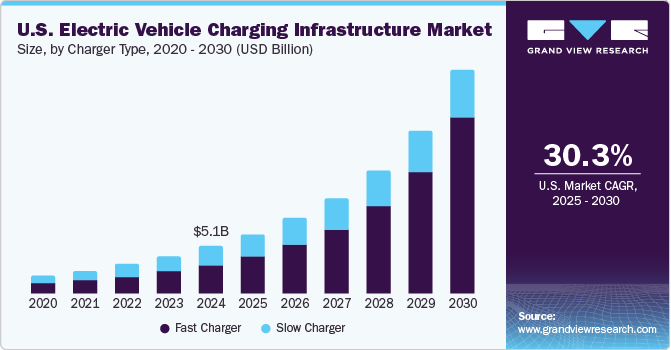In the thrilling world of electric vehicles, their speedy acceleration and environmental perks often steal the spotlight. But there’s another equally gripping storyline unfolding quietly behind the glitzy EV facade — the developing landscape of charging infrastructure in the USA. While the EV revolution is steadily picking up speed, a range of complexities and potential await exploration. Let’s buckle up and dive into this high-voltage epic brewing under our electric noses, examining the promises and predicaments of the charging infrastructure in the land of opportunity.
Understanding Electric Vehicle Charging Infrastructure

We’ve got to geek out a bit and delve into the electrifying world of electric vehicle charging infrastructure. It’s not exactly something we flippantly discuss over a breakfast burrito, but it’s paramount when it comes to navigating the electrified highways and byways of tomorrow.
When we talk about charging infrastructure, we’re discussing two things primarily— charging stations and their distribution. Now, to the untrained eye, a charging station resembles an oversized smartphone charger, but there is a tad more science behind the facade. These stations house the equipment used to send electricity into a car’s battery, in a safe and controlled manner.
Furthermore, charging stations fall under three categories based on power outputs. Level 1 chargers, the slow coaches of the bunch, utilize a standard 120-volt AC house plug, and can spend a good day getting a vehicle fully charged. Level 2 chargers pick up pace, with 240-volt AC power sources, often found in residential or commercial buildings. They can refuel a battery in about 4-8 hours. Then we have the grand poobah, DC fast chargers. As the name suggests, these speed demons can have a battery at 80% within 20-30 minutes; however, they give your car’s battery the equivalent of a burger binge at a fast-food joint, okay for a quick top-up, but not so grand for preserving long-term battery health.
Distribution, on the other hand, refers to the strategic placement of these charging stations. Not unlike the well-considered location of your favorite coffee shop. Distribution tackles the need for chargers in different locations, such as urban and residential areas, or long-distance travel routes where chargers are farther apart.
What’s key here is understanding that all these elements mean jack unless there’s a power grid that can support them, importantly during peak charging times. It’s like having VIP passes for a concert but no transport to get there. The electricity calls for a grid that can handle such a load, which in turn relies on power generation and distribution systems. And just like an all-you-can-eat buffet, you can’t enjoy the spread unless the chicken wings keep flying out the kitchen.
So, the nitty-gritty? Electric vehicle charging infrastructure is a blend of heavy-metal hardware and strategic mastery. It’s a dynamic interplay of stations, charges, locations, and yes, a robust, dependable power grid to tie it all together as sweetly as a cherry tops off a sundae.
Current State of Charging Infrastructure in the USA

Within the borders of the U.S., the electric vehicle (EV) charging infrastructure sparks conversation and debate. Commendably, on the whole, there has been broad-scale expansion and an upward trajectory in recent years. Peering at the statistics, we see around 96,000 public charging outlets scattered across the nation, ready to juice up EVs at any given moment. But don’t get overly electrified with this number—in comparison, there are approximately 111,100 gasoline stations nationwide, not accounting for the individual pumps each station usually touts.
Diversity in charging options adds another dimension to the story. Commuters get to choose between Level 1, Level 2, and Direct Current Fast Charging (DCFC) stations. The majority, around 80%, are Level 2 chargers, perfect for topping up your EV while you enjoy a Costco-size shopping spree. Yet, these charging oasis are majorly located in urban and suburban areas, creating a dearth in rural zones.
Now, let’s cruise over to the dynamic segment of the DCFC which furnishes responses to the question—how fast can you charge an electric vehicle? Packed with potent power, these ultra-fast chargers can push you back on the road within minutes—a boon for long-haul drives. Alas, they are not as ubiquitously dotted on the map as one might hope. And even when they are around, compatibility becomes a sticking point, with CHAdeMO and Combined Charging System (CCS) plugs duking it out in the DC-fast realm.
Peeping into the provision landscape, it’s a playground of big names. Tesla remains a dominant player, flaunting more than 25,000 Superchargers across North America. Keeping pace, others like ChargePoint, EVgo, and Electrify America have inscribed their networks on the backbone of the U.S. charging infrastructure.
Despite strides in development, the U.S. charging context is something of a scatter plot rather than a cohesive network. Absence of a unified national strategy appears evident. The rush-hour cities glow with charging points, awash with options, but the rural areas present tumbleweeds and shadows, with charging stations as scarce as hen’s teeth. Charging infrastructure is tantamount to the roadway for the EV, and for the moment, it seems we have only partially paved the path.
Challenges Faced in Expanding the Charging Infrastructure

The expansion of charging infrastructure across the United States is akin to threading a gargantuan camper through a multitude of narrow city streets, excruciatingly tricky and laden with challenges. To make our journey towards a fully-electrified America possible, we’ve got to overcome some significant roadblocks first.
First off, the leap from gasoline stations to charging points is not as easy as swapping out T-shirts. It involves a mammoth endeavor built around foundational electrical work and untangling bureaucratic red tape. Traditional gas stations can be set up almost anywhere with minimal infrastructure because the fuel is delivered by trucks. However, EV charging stations need to be strategically located near the power grid, which is not always conveniently located for motorists in need of a charge.
Secondly, fast-charging infrastructure requires a considerable supply of electricity—something that isn’t always readily available. High-powered chargers can suck up electricity at a rate that would make your hair stand on end. Traditional power grids may whimper under the sudden load of dozens of EVs trying to gulp down gigawatts of power. Hence, expanding the charging infrastructure without parallel improvements to the grid could lead to the unpleasant scene of unexpected blackouts.
Another barrier lies in the future-proofing of charging infrastructure. The pace of technological innovations leaves one panting for breath. No one wants to pour money into installing charging equipment that might become obsolete before it can even spin a decent profit. Add to this the issue of compatibility – a variety of charging plugs and standards currently coexist in the market, which can lead to quite the maze for consumers and operators alike.
Lastly, there’s the conundrum of cost versus demand. Public charging infrastructure is an expensive investment. And while the number of electric vehicles on the road is rapidly multiplying, it’s not yet at the level where people are elbowing each other out of the way for a charging point at every corner. Operators are caught in a catch-22 situation: until there are enough EVs, investing heavily in charging infrastructure is like shooting in the dark; however, until there’s sufficient charging infrastructure, potential EV buyers might remain just that – potential.
But let me say this straight: these challenges are not insurmountable. Yes, the objects on the road to a fully electrified America are sizeable, but they come with ample opportunities, which the next section will explore.
Opportunities for Growth in Charging Infrastructure

In viewing the picture at large, one can’t help but note the myriad opportunities for growth in the charging infrastructure in the United States despite the challenges that abound. As the electric vehicle (EV) market continues to take strides in popularity, so does the demand for an accessible, varied, and widespread charging network. Opportunities are knocking at the door, it’s up to us whether we answer.
One of the most prominent opportunities lies in the potential for technological advancements. Rapidly evolving tech, such as speedy Level 3 chargers or inductive (wireless) charging systems, could dramatically streamline the charging process. This could not only reduce the time EV owners spend charging, but also, help reframe the current public sentiment around charging EVs as an inconvenient chore.
Additionally, a realm untouched by many is the symbiosis of EV charging stations and renewable energy. Capitalizing on harnessing solar or wind energy for powering charging stations could take a considerable load off the grid, while further improving the carbon footprint of EVs.
Untapped areas in terms of geographic spread also present immense growth potential. Expanding the charging infrastructure to rural and remote areas can make EVs a feasible option for a larger part of the populace. This could literally and figuratively drive the next wave of EV adoption.
However, for this growth to be possible, collaboration is key. Private companies, automakers, and the government need to work hand in hand to create a conducive environment for charging infrastructure expansion. Public-private partnerships can help fund this development while sharing the associated risks.
Incorporating charging stations into existing infrastructure is yet another opportunity waiting to be seized. Airports, shopping centers, public parking lots, and even highways can function as convenient charging points. This integrated infrastructure planning has the dual advantage of increasing charging points and reducing ‘range anxiety’ for EV users.
Furthermore, there is a need to consider new business and pricing models. From subscription-based services to pay-as-you-go, ensuring a flexible and fair pricing structure could encourage more EV owners to use public charging infrastructure rather than relying solely on home charging.
In conclusion, while the path to broadening the charging infrastructure might be fraught with complexities, the silver lining is bright. With targeted efforts, strategic alliances, and innovative thinking, the opportunities are ripe for the taking. And as we seize these opportunities, we are not just boosting an industry but accelerating a vital shift towards cleaner, more sustainable mobility.
Case Studies of Successful Implementation

One of the critical indicators of viable electrification strategies is an array of successful implementations across the nation. Transitioning from prototypes and theory into practical, everyday use demands robust analysis of such successes. Let’s drive on the road taken by those who managed to accelerate the charging infrastructure growth.
One example is Portland, OR – a cityscape that breaks common stereotypes. With proactive planning and forward-thinking policies, such as the Electric Vehicle Strategy adopted back in 2010, the city positioned itself to foster a conducive environment for charging infrastructure growth. It now boasts one of the densest networks of charging stations and has curbed range anxiety for its electric vehicle (EV) drivers.
The California state also shines as a success story, where policies like the Electric Vehicle Charging Station Financing Program have catalyzed an unprecedented jump in charger installations. By enticing building owners and landlords with lucrative incentives to install electric vehicle charging stations, this initiative has managed to connect the state’s major cities with a vibrant web of charging points and become the electrified trailblazer.
Then there’s Burlington, VT – the small city stands as a titan for public electric vehicle charging infrastructure. Leveraging a partnership with the local utility and opportunistic grant funding, Burlington effectively doubled its public charging stations in just under two years.
In Denver, CO, public and private partnership has been leveraged to provide multifamily housing developments access to charging facilities, addressing an often-overlooked need in the EV charging ecosystem. With most EV charging taking place at home, not having access to residential charging can be a significant roadblock to EV ownership. In response, Denver’s City County’s excelled with its “Charge Ahead Colorado” program, providing grants to qualifying applicants to install charging stations.
Each of these case studies underscores the symbiotic relationship between public policies, incentives, planning, and successful implementation of charging infrastructure. While geographical and socio-economic variations demand unique approaches, these examples highlight how forward-thinking strategies can produce tangible results. With determination and a coherent plan, no obstacle appears insurmountable for the future of EV charging infrastructure in the United States.
Sustainable Practices in Charging Infrastructure Development

As we deep dive into the matrix of improving infrastructure, let’s get our hands dirty with the conundrums of ensuring that this monumental shift to electric power is indeed sustainable. Because well, it ought to be eco-friendly, right? That’s the overarching motive here.
One can’t methodically plan a massive network of chargers without tapping into renewable energy resources. Enter the sun, wind, and biofuels— the unsung power troupes that, when harnessed well, could provide a majority of the energy required to keep those batteries juiced up. Implementing solar panels on charging stations is an effortless way to spell sustainability and a widespread practice that’s just as effective. Just consider it juicing up your EV directly from the sun, minus the middleman.
In the process of drafting in the renewable energy cavalry, let’s not forget the smart grid systems that guide the flow of electricity to where it’s needed—when it’s needed. Working in harmony with renewable power sources, smart grids pave the way for a new era of ‘demand response programs.’ They automatically adjust power delivery based on current conditions. This degree of flexibility is a boon, considering the variable nature of renewable power generation.
Furthermore, energy storage systems—or giant batteries if you will—have a crucial role in making the charging infrastructure sustainable. By storing excess power, they act as a crucial buffer that ensures that the greens in your battery stay put, even when the sun goes down or when the winds aren’t so generous.
And while we itch to jack up the charging speed for convenience, it’s imperative to maintain a degree of control. Rapid charging, while undeniably convenient, places a significant strain on the power grid. A practical and sustainable solution might entail incentivizing off-peak charging or using smart systems that distribute power based on demand and grid capacity.
Finally, developing sustainable charging infrastructure also necessitates the utilization of green construction and design principles. Employing recyclable materials, minimizing land use, and optimizing site selection for minimal environmental disturbance can dramatically reduce the infrastructural strain on Mother Nature.
Sustainable development of charging infrastructure isn’t an option; it’s a necessity etched in the small print of our collective agreement to shift towards electric mobility. For a truly green revolution, it’s not just the cars that need to go electric—it’s their life support, too. So let’s give some thought to our grid, folks!
Potential Impact on the Automotive Industry
A concerted push for an expanded charging infrastructure can fundamentally change the face of the automaking industry. With the ascendency of electric vehicles (EV’s) and other modes of electrified transport, automakers are now in a race to dominate this emergent market, forcing a rethink of how their vehicles are fueled.
As charging infrastructure becomes increasingly available and convenient for consumers, we can anticipate a corresponding increase in the consumer adoption of EV’s. However, this transition will require automakers to grapple with a clutch of inconvenient realities. They will need to retool their manufacturing processes, re-engineer vehicle designs, and invest significantly in battery technology, to name a few.
This development could also catalyze what I’d call a Detroit Renaissance, facilitating a shift from the motor city’s conventional approach to vehicle manufacture to a more futuristic one that emphasizes clean tech. Assuming automakers can meet these challenges, we could expect a significant boost in jobs and investments, not just in Detroit but throughout America. If automakers can seize this opportunity, we can look forward to a healthier environment, a revitalized industry, and greater energy independence.
Simultaneously, as the charging infrastructure grows, the day-to-day functioning of auto dealerships could undergo swift alterations. The sales pitch for an electric vehicle differs from that of a gasoline-powered one, especially when it comes to explaining charging infrastructure and battery performance. Car dealerships would need to adapt by adopting a more holistic sales approach that covers these details.
Lastly, while the spotlight is often on the auto manufacturers and their sleek new electric models, let’s not forget the role of vehicle-service providers. As the number of EV’s increases, vehicle service centers will need to acquire specialized knowledge and skills to deal with EV maintenance and repair.
So, the potential impact on the automotive industry won’t just end at the manufacturing stage. It’s a complete overhaul of how we conceive, produce, sell, and service our vehicles, and it’s becoming clear that the infrastructure to charge these new breeds of cars will play a quintessential role. This wave of change should, ideally, lead us to a more sustainable automotive ecosystem.
FAQs
What are the major challenges for charging infrastructure in the USA?
Well, my friend, you might as well ask what the challenges are of teaching a penguin to play piano! First off, there’s a woeful lack of charging stations out there in the wild blue yonder. It’s a bit of a chicken-egg situation: fewer electric cars due to not enough charging stations, and not enough charging stations due to fewer electric cars. Secondly, charging a car ain’t exactly as speedy as filling a gas tank, you might need to catch up on Game of Thrones while you wait. And let’s not forget the grand power grid – it’ll need to flex its muscles a good deal more to handle the load once electric cars really hit their stride.
What kind of opportunities does this pose?
Oh, there’s a gold mine of opportunities if you’re game! Think of the Tesla Supercharger network, sprouting up like kudzu. There’s a lot of room for entrepreneurship – from setting up charging station networks, to offering at-home installation services or even apps to locate the closest charging point (a high-tech version of the ol’ watering hole). Companies could even offer lounge-style waiting areas for folks to chill while their cars rejuvenate. Opportunities, ya see, are kind of like cockroaches – there’s always more than you think, and they can thrive in the craziest places!
Conclusion
Despite the challenges, the quest for an extensive charging infrastructure in the USA is on a forward trajectory. Industry players, government agencies, and private owners are collaborating to translate this massive undertaking into reality. As the electric vehicle revolution accelerates, the opportunities for greater sustainability, improved economic growth, and a cleaner environment are increasingly within reach. The road may be long, but America is getting charged up and rolling out for a greener future.
